|
|
Donovan

|
|
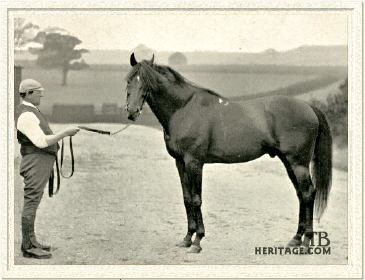 |
|
|
Donovan was undoubtedly one of the best British racehorses of the late nineteenth century, as his record of only three defeats in 21 starts attests. Fated to live in the shadow of another brilliant Galopin son, his near-contemporary St. Simon, his legacy is through the descendants of his daughters.
Donovan was bred by one of the most successful and popular gentlemen of the English turf, William Cavendish-Bentinck, the 6th Duke of Portland. The Duke was a young man in his twenties in the early 1880s, and it was at this time he began to form his breeding operation. One of his early purchases was a fat, unraced colt named St. Simon, who went on to become acknowledged as one of the greatest horses of the English turf by the time he retired, unbeaten on the racecourse. Another fortuitous purchase was the filly Mowerina.
|
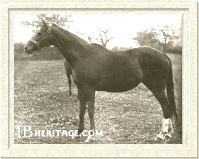
Mowerina
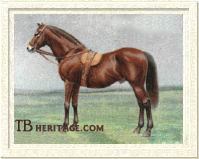
Galopin
| |
Mowerina was bred in Denmark by Otto Scavenius and foaled in 1876. Her sire was Scottish Chief, a winner of the Ascot Gold Cup. Her dam, Stockings, was a daughter of the "Emperor of Stallions," Stockwell, out of Go-Ahead, a full sister to Triple Crown winner West Australian. Mowerina was sent to England, and raced in the colors of Lord Rossmore. She proved to be a durable, classy filly, winning sixteen races, including the Portland Plate, Houghton Handicap, and Molyneux Cup. She possessed brilliant speed up to six furlongs. The Duke of Portland purchased her upon hearing the opinion of Lord Falmouth, who thought Mowerina was the best broodmare prospect to be found in Great Britain.
With such a positive recommendation, Portland readily purchased Mowerina from Lord Rossmore for £1400. For her first mating, in 1882, Portland decided to send her to Galopin, a young stallion with an extraordinary pedigree. Galopin was sired by Two Thousand Guineas winner Vedette, a son of Derby winner Voltigeur. Dam of Galopin, was the mare Flying Duchess, a daughter of another Derby champion in The Flying Dutchman, Voltigeur's great racetrack rival. Galopin had lived up to his breeding, winning the Derby Stakes in 1875.
|
Portland had good reason to send mares to Galopin, for about this time, he purchased the mare Atalanta, a Galopin daughter which had good form on the racetrack. The Galopin filly Corrie Roy and the Galopin colt Galliard were two other highly regarded offspring of the Derby winner, who had initially not been well received as a stallion. The best was yet to come, for St. Simon was foaled in 1881.
Mowerina's first mating with Galopin yielded the filly Modwena, winner of nine races and considered the best two-year-old filly of 1884. After producing a filly by Hampton in 1884 and producing no live foal in 1885, Mowerina was again sent to Galopin and the result was Donovan. Mowerina was subsequently mated with St. Simon on four occasions, with two of the resultant foals being of the highest class--the classic-winning filly Semolina and the classics-placed Raeburn.
Donovan was a strong, handsome colt, a light bay like his ancestor West Australian. When he had fully developed, Donovan topped out at 16 hands, his girth measured 74.5 inches and his cannon bone measured 8.5 inches. He was every inch a magnificent specimen of the thoroughbred.
Donovan on the Turf
Early on Donovan gave every indication that he possessed talent of the highest order. He was sent to be trained at the Newmarket yard of George Dawson, nephew of the renowned trainer Matt Dawson. The younger Dawson showed no inclination to keep his charge in cotton wool, sending Donovan out thirteen times as a two-year-old. Indeed, the Duke himself showed no reticence about racing his horses hard, having run Mowerina seven times in 1882 while in foal and allowing Modwena to race twice in a single afternoon.
Donovan was the dominant two-year-old of his year, for he won eleven of his thirteen starts that season and captured nearly every major juvenile race. The list of victories compiled by the Duke of Portland's colt included the Brocklesby Stakes at Lincoln, the Portland Stakes at Leicester, the New Stakes at Ascot, the Hurstborne Stakes at Stockbridge, the July Stakes at Newmarket, the Ham Stakes at Goodwood, and all of Newmarket's prestigious races for juveniles -- the Buckenham Stakes, the Hopeful Stakes, the Middle Park Plate, and the Dewhurst Plate.
Donovan went into winter quarters the prohibitive favorite for the next spring's classic races. Donovan showed he had lost none of his form on his reappearance to the races in the Prince of Wales's Stakes at Leicester, for he beat Pioneer and the good filly Minthe decisively. Minthe went on to capture the One Thousand Guineas.
Donovan was a firm favorite for the Two Thousand Guineas. It caused a major shock when he was beaten just a head by the outsider Enthusiast, a colt Donovan had soundly beaten in the Middle Park Plate and the Prince of Wales's Stakes.
The surprising defeat proved an anomaly, as in his next start, the 1-1/4 mile Newmarket Stakes, Donovan easily won over sixteen others, Enthusiast running unplaced. The Derby was much the same. With Tommy Loates in the saddle, Donovan stalked the pace set by Gulliver and The Turcophone, took the lead after Tattenham Corner and cantered home by one and a half lengths. The Fernandez colt Miguel was second, El Dorado third, and Enthusiast fourth.
Donovan's performances the rest of the season were masterful. His next start was at Royal Ascot, in the Prince of Wales's Stakes, which he won easily, Enthusiast running third. Rested until the autumn, Donovan was not seen out again until the St. Leger, which he won from Miguel by three lengths. His next start was the Lancashire Plate, ten days after the St. Leger. The field was exemplary, consisting of fellow classic winners Enthusiast, Minthe, and Seabreeze, victress the previous season in the Oaks and the St. Leger. Donovan again won easily. The last race for Donovan that season was the Royal Stakes at Newmarket. Only the filly Minthe was sent to challenge him, and again she could not get the better of the Duke's brilliant colt.
Sadly, the Royal Stakes proved to be Donovan's last race. It was intended to keep him in training as a four-year-old with the goal of winning the Ascot Gold Cup, but he broke down in his training and was retired. All told, Donovan captured eighteen of his twenty-one starts and earned £55,443, at that time a world record for purse money won.
Donovan in the Stud
Comparisons between St. Simon and Donovan were inevitable. St. Simon was certainly the more brilliant of the pair and during his career, was never really extended. He participated in ten races to Donovan's twenty-one, St. Simon emerging undefeated. Donovan claimed two classic victories, St. Simon unable to run in the classics due to the rule then in force which rendered void his classic engagements upon the death of his nominator. Conversely, St. Simon won the Ascot Gold Cup, which Donovan was unable to participate in due to career-ending injury. Because of his brilliance and dominance, St. Simon grabbed the spotlight, though Donovan was a performer of nearly equal dominance. The looming specter of St. Simon followed Donovan into the breeding ranks.
At the time of Donovan's retirement, St. Simon was the premier stallion at the Duke of Portland's Welbeck Abbey Stud in Nottinghamshire. Consequently, Donovan did not stand there, standing for a time at Rufford Abbey Stud, where he stood for a fee of 200 guineas in 1898. He later stood at Worksop Manor Stud. St. Simon was the most fashionable stallion in Britain at this time, and Galopin was still an active and virile stallion, which he remained right up until his death in 1899. With such competition, Donovan did not enjoy the company of the best mares in the breeding shed. He did get some good mares, but not nearly the quantity which went to St. Simon or Galopin. Donovan has been criticized for his failure to sire a British classic winner. But given the opportunities presented to him, he was a successful stallion nonetheless, ranking among the top twenty stallions in Britain seven times. |
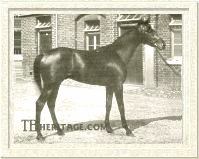
Velasquez
| |
Undoubtedly the best horse sired by Donovan was VELASQUEZ, a bay colt out of Vista, by Macaroni, foaled in 1894. Vista had previously foaled two classic winners, Two Thousand Guineas winner Bona Vista and Derby winner Sir Visto. Velasquez might well have been her third were it not for the fact that he had the misfortune to be foaled in the same year as Galtee More, the colt who would capture the Triple Crown in 1897.
Velasquez was bred by Archibald Philip Primrose, 5th Earl of Rosebery, elected Prime Minister of Great Britain the year Velasquez was foaled. Velasquez was trained by William Walters at Newmarket.
|
As two-year-old, Velasquez won four of five starts, including the New Stakes, the July Stakes, and the Champagne Stakes. He met Galtee More for the first time in the Middle Park Plate and was soundly beaten.
At three, Velasquez was convincingly beaten by Galtee More in both the Two Thousand Guineas and the Derby. Velasquez had to settle for wins in the Princess of Wales's Stakes and the Champion Stakes, a second to Persimmon in the Eclipse Stakes and to Love Wisely in the Jockey Club Stakes. The next season, as a four-year-old, Velasquez added the Eclipse Stakes and a second running of the Champion Stakes to his resume.
Sadly, Velasquez died young, at the early age of twelve. He sired several good winners, including Desiree, a winner of the Gimcrack Stakes and Admiral Breeze, a winner of the Doncaster Stakes. The most significant offspring of Velasquez was his daughter Valve. A winner of eight races, she became the dam of the Dark Ronald filly Vaucluse, winner of the One Thousand Guineas in 1915.
|

Matchmaker
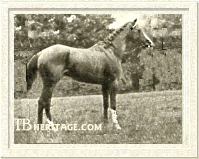
Veronese
| |
MATCHMAKER, out of the Plebeian mare Match Girl, was a foal of 1892. He won such major races as the Prince of Wales's Stakes, the Ascot Derby, the King Edward VII Stakes, and the City of London Breeders' Foal Plate. He was not a highly successful stallion, but did sire Handicapper, a winner of the Two Thousand Guineas and the filly Mother-in-Law, dam of the fine stayer Son-in-Law.
VERONESE, out of Maize, by Hampton, was a foal of 1898. Veronese was classics-placed, running third in the Derby of 1901 to William Collins Whitney's colt Volodyovski. Veronese won the Prince of Wales's Stakes at Ascot and the Zetland Plate at Newmarket. He did not leave a lasting legacy as a stallion.
O'DONOVAN ROSSA was a chestnut gelding, foaled in 1897 from an unnamed daughter of Barcaldine. O'Donovan Rossa was a winner of eleven races in his career, including the Molcomb Stakes and the Stewards' Cup at Goodwood and the Great Surrey Breeders' Foal Plate at Epsom.
If Donovan's sons were something of a disappointment, his daughters made amends, for he sired some fine race mares and several of his daughters were important producers who extended his presence in the pedigrees of great runners on virtually every continent.
|
PFAUENINSEL (1894) was a daughter of Donovan which was a top racemare in Germany. Her dam, Ponza, by Springfield, was a half sister to the good horse Orvieto. She counted for the Preis der Diana (German Oaks) among her victories.
SESARA, born in 1896, was foaled in France from the Bruce mare Seraphine. Her victories included the Poule d'Essai des Pouliches (French One Thousand Guineas) and the Prix Vermeille. As a broodmare, she foaled a daughter by Bay Ronald, then standing in France, named Miss Ronald. Her significance comes as the dam of the Sundridge filly Beach Talk, destined to become the dam of several horses bred by E.R. Bradley in Kentucky, notably Hollywood Gold Cup winner Big Pebble (by Black Servant).
DONNETTA, out of the Wenlock mare Rinovata, was a foal of 1900. Donnetta was bred by Sir Simon Lockhart and raced for him during the early part of her career. She was then sold at the 1904 Newmarket July Sales and purchased by Lord D'Abernon for 450 guineas. Donnetta was a good filly on the track, winning thirteen races, including the Duke of York Stakes and the Great Jubilee Handicap at Kempton Park. Upon her retirement, she was sent to her owner's Esher Place Stud in Surrey.
|
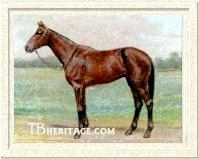
Donnetta
| |
As a broodmare, she excelled. She produced One Thousand Guineas winner Diadem (1914), Two Thousand Guineas winner Diophon (1921), Irish St. Leger winner Dionysos (1915), and some excellent producing daughters.
Diadem, by Orby, was bred and owned by Lord D'Abernon, During her racing career she also added the July Cup (twice), two runnings of the Rous Memorial Stakes, the Cork and Orrey Stakes, the Coventry Stakes, and a second place finish in the Oaks to her laurels. She later produced the good horse Diadochos (1923, by Son-in-Law). |
Diophon, by Orby's son Grand Parade, came up for sale at the Doncaster sales, and was purchased for 4000 guineas by George Lambton, acting on behalf of H.H. the Aga Khan. Diophon was the best two-year-old of his year, capturing the July Stakes and the Middle Park Stakes. At three, his only victory came in the Two Thousand Guineas. As a stallion, Diophon sired Alberta, a French-bred filly imported to the United States where she won the Alabama Stakes; Diolite, winner of the Two Thousand Guineas and later a three-time leading sire in Japan; El Draque, a stakes winner in India; and Theresina, victress in the Irish Oaks and dam of St. Leger and Irish Derby winner Turkhan, as well as two other classics-placed runners and another colt, Eboo, who went on to become a classic sire in Brazil.
Donnetta's son, Diadumenos, a full brother to Diadem, was a winner of the Great Jubilee Handicap at Kempton Park and was sold as a sire to German interests. His son, Diapason, foaled when his sire was still standing in England, captured the Two Thousand Guineas. A son of his from his crops in Germany, named Volumnius, captured the Grosser Preis von Duesseldorf.
In France, Donnetta's daughter, Tiara (1920, by Flying Fox) was the dam of the Epinard son Emir d'Iran, winner of the Prix d'Arenberg, and also was dam of several good daughters: German Derby winners Alpenkonig and Alarich both descend from Donnetta via Tiara's daughter, Alex (by Louqsor). Donnetta's daughter Dona Sol (1908, by Ayrshire), was second dam of Irish St. Leger winner Sunny View, July Stakes winner Apple Sammy, and, through Apple Sammy's dam, Lady Phoebe (1917, by Orby), was tail-female ancestress of some good runners, including Derby and Prix de l'Arc de Triomphe winner Sea Bird (1962, by Dan Cupid) and Belmont Stakes winner High Echelon.
Three of Donovan's daughters who were influential to succeeding generations were STRIKE-A-LIGHT, BERRIEDALE, and ALTOVISCAR. The oldest of these mares was BERRIEDALE, foaled in 1894. She was bred by the Duke of Portland and was out of Caithness, a half-sister, by Bend Or, to dual classic winner Ayrshire. She was modest as a runner, placing second in the Ham Stakes. As a broodmare, she was purchased by William Collins Whitney and imported to the United States. Mated to Hamburg, she produced the stakes-winning colt Inflexible and the filly Biturica, destined to become the dam of champion filly Maskette and third dam of Kentucky Derby champion Bubbling Over.
Another daughter of Berriedale was the Ben Holladay filly Ophirdale. This filly, when mated to the Ormonde son Ormondale, produced Princess Ormonde. This filly's daughter by Superman, a filly named Ormonda, was a stakes winner, but was more noteworthy as a producer. Her sons Brevity and Osmand were multiple stakes winners who each placed second in the Kentucky Derby. Ormonda's daughter, by Sweep, was a good producer for Warren Wright's Calumet Farm. Named Dustwhirl, she became the dam of major stakes winner Reaping Reward; the filly Panoramic, destined to become the dam of significant producer Honeymoon; and Triple Crown winner Whirlaway. Ormonda's family is still actively producing first rate runners, with such prominent individuals as Whirlabout, Spinning Top, Great Circle, Honeys Alibi, Honeys Gem, Market Basket, Cresta Rider, champion filly Furl Sail, and champion filly Halfbridled, all tracing Dustwhirl.
Berriedale's daughter Welbeck, by Kinley Mack, wound up in Uruguay. She became the third dam of dual Gran Premio Carlos Pelligrini champion Romantico.
STRIKE-A-LIGHT, foaled in 1896, was another beautifully-bred filly, for she was out of Fuse, a half-sister, by Bend Or, to Epsom Derby winner St. Blaise. Her importance comes via her daughter Crepuscule, a filly by Meddler. Crepuscule was bred in France and was exported to the United States as a broodmare. As a producer, she foaled Evening, a filly by St. James which beat males in the Florida Derby. Evening's half-sister, Stefana, was a winner who later became the dam of Stefanita, a champion filly whose victories included the Test Stakes and the Alabama Stakes. Armada, another daughter of Crepuscule, was sired by Man o' War. A non-winner, she became a major producer in her own right. Her daughter by Jack High, named High Fleet, was named champion three-year-old filly of 1936 when she captured the Coaching Club American Oaks. High Fleet's younger full sister Flota was a winner of one race. She served her career as a broodmare as a member of Isabel Dodge Sloan's Brookmeade Stable band. She produced several winners, her most important being a son of Eight Thirty named Sailor. A contemporary of Swaps, Nashua, and Summer Tan, he picked up his share of stakes wins, including the Pimlico Special and the Gulfstream Park Handicap. At stud, Sailor sired champion filly Bowl of Flowers and champion colt Ahoy.
ALTOVISCAR was foaled in 1902. She was out of the Kilwarlin mare Navaretta. Altoviscar was a modest winner on the racetrack. She captured the Devonshire Plate and finished second in the Fitzwilliam Stakes and the Kedleston Handicap. As a producer, she bred eleven foals, five of whom were winners. It was via her daughter, the Gallinule filly Alope, that her influence spread to future generations.
Alope was a smart sprinting filly on the racetrack, winning the Moulton Stakes, running second in the One Thousand Guineas, and third in the Champion Breeders' Foal Stakes, Burwell Plate, and the Fern Hill Stakes. Alope got off to a rocky start as a broodmare, producing only three foals and coming up barren five times in the first eight years of her reproductive career. Sold to Donald Fraser, master of Tickford Park Stud, she proved better. In 1922 she foaled a colt by Son-in-Law, and both she and her colt were then sold to Sir Abe Bailey. The colt was Foxlaw, a fine stayer, winner of the Ascot Gold Cup and sire of Ascot Gold Cup winners Tiberius and Foxhunter.
A full sister to Foxhunter arrived in 1926. Named Aloe, she was sold to Lord St. Davids, for whom she performed well on the track, running second in Haverhill Stakes to Pennycomequick, the winner of the Oaks, and second in the important Nassau Stakes.
Aloe, the granddaughter of Altoviscar, became the matriarch of a female family which has become one of the most important classic producing tribes of the twentieth century. Through her daughter Aroma the family has counted such standouts as Obeah, Go For Wand, Atan, Tamarett, Known Fact, Secrettame, Tentam, Tappiano, and Gone West. Aloe's daughter Feola, a classics-placed Friar Marcus filly, founded a branch of the family which has included Above Board, Above Suspicion, Angelola, Aureole, Hypericum, Highclere, Height of Fashion, Unfuwain, Nashwan, Nayef, Love Game, Knight's Daughter and her two important offspring--major producer Monarchy and multiple American champion Round Table. Finally, Aloe's daughter Sweet Aloe, a filly by Cameronian, became ancestress of such notable performers as Alcide, Parthia, Flame of Tara, and Salsabil.
Another Donovan daughter, DON'S BIRTHDAY (1902), out of the Bend Or daughter, Tay, won the Minting Juvenile Plate at Lincoln, and placed second twice in eight starts at age two, and at age three won the Musselburgh Handicap at Edingburgh, her only win in five starts. In the stud, she produced Polloia (1910, by Polymelus), a modest winning plater, and Peppermint (1917, by Spearmint). Both these daughters bred on (Family 2 - d); the great French race filly, Mistress Ford (1933, by Blandford), was a grandaughter of Polloia, and her daughters produced some top runners in France.
Donovan's daughter, TAIA (1892), out of the Kisber mare, Eira, produced the good stayer Radium (1903, by Bend Or), who won ten of his twenty-four races, including the Doncaster Cup and the Goodwood Cup. Radium got Night Raid (1918), a leading sire in Australia who got the great Phar Lap.
Donovan was shot on February 1, 1905. The stallion had severely injured himself after running into a tree in his paddock at Worksop Manor Stud, necessitating his destruction. He was interred at Welbeck Abbey Stud and his hide was presented to Heath House, Newmarket.
-- Liz Martiniak
|
|
|
|

